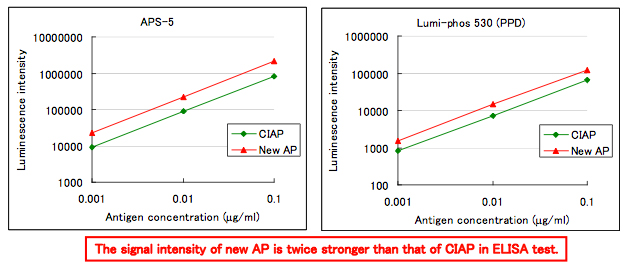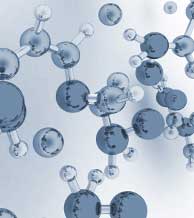Alkaline phosphatase from Microorganism
 |
|---|
| Description: | Alkaline phosphatase (E.C.3.1.3.1) |
|---|---|
| Reaction : | Orthophosphoric-monoester + H₂O → alcohol + Orthophosphate |
| Origin : | Microorganism (Bacterium) |
| Specific activity : | ≧6,000 U/mg-protein (37°C・pH=9.8, pNPP is used as a substrate) |
| Molecular weight : | Approx. 100,000 (by gel filtration) |
| Optimum pH : | Approx. 9.8 |
| pH stability : | 6.4 – 9.0 (25°C, 24hr) |
| Thermalstability : | ≦60°C (pH7.5,1hr) |
| Stabilizer : | Mg²⁺、Zn²⁺ |
| Available substrates: | p-Nitrophenyl phosphate, Dioxietane-based substrates, Acridan-based substrates, 5-Bromo-4-Chloro-3-Indoxyl Phosphate (BCIP), 4-Methylumbelliferyl Phosphate, etc. |
| Stability : | Stable at 4° |
3. The data in ELISA test

4. Alkaline phosphatase ASSAY
Principle:
Alkaline phosphatase
p-Nitorphenylphosphate (pNPP)+H₂O ► P-Nitrophenol + Pi
The appearance of p-Nitrophenol is measured at 405nm by spectrophotometry .
Unit definition:
One unit causes the formation of one micromole of p-Nitrophenol per minute under the conditions described below .
Method:
| A. Diethanolamine buffer: | 1M [Dilute 9.66ml of diethanolamine (MW=105.14) in 60ml H₂O, add 5ml of 0.1M MgCl₂ and, after adjusting the pH at 37°C to 9.8 with 2N HCl, fill up to 100ml with H₂O] |
|---|---|
| B. pNPP solution: | 0.674M [2.5g p-Nitorphenylphosphate disodium salt (MW=371.16) / 10ml Diethanolamine buffer (A)] (Prepare freshly) |
| C. Enzyme diluent: | 30mM Triethanolamine, 1mM MgCl₂ , 0.1mM ZnCl₂. 0.1% Triton X-100 pH=7.6 |
Procedure
| Concentration in assay mixture | |
|---|---|
| Diehtanolamine | 0.97 M |
| P-Nitrophenylphosphate | 11 mM |
| MgCl₂ | 4.8 mM |
1. Prepare the following working solution (30.5ml) in a brownish bottle and store on ice. (Prepare freshly)
30ml Diethanolamine buffer (A)
0.5ml pNPP solution (B)
2. Pipette 3.0ml of working solution into a cuvette (d=1.0cm) and equilibrate at 37°C for about 5minutes .
3. Add 0.1ml of the enzyme solution* and mix by gentle inversion.
4. Record the increase of optical density at 405nm against water for 3 to 5 minutes in a spectrophotometer
thermostated at 37°C, and calculate the ΔOD per minute from the initial linear portion of the curve (ΔODtest) . At the same time , measure the blank rate (ΔODblank) by the same method as test except that the enzyme diluent (C) is added instead of the enzyme solution .
* Dilute to 0.1 – 0.3 U/ml with ice cold enzyme diluent (C), immediately before assay .
Calculation
Activity can be calculated by using the following formula :

ΔOD/min (ΔOD test-ΔOD blank)×Vt×df
Volume activity (U/ml) = = ΔOD/min×1.676×df
18.5×1.0×Vs
- Vt
- : Total volume (3.1ml)
- Vs
- : Sample volume (0.1ml)
- 18.5
- : Millimolar extinction coefficient of p-Nitrophenol under the assay conditions (㎠/micromole)
- 1.0
- : Light path length (cm)
- df
- : Dilution factor
To get a quote, contact us at info@toyobousa.com, or INQUIRY.